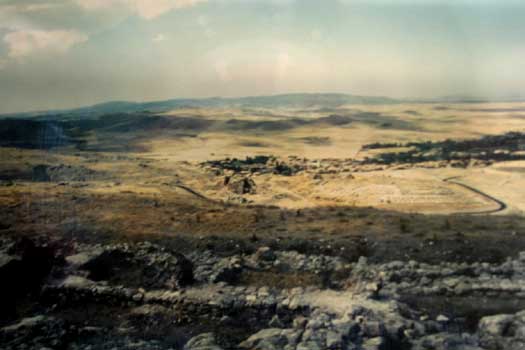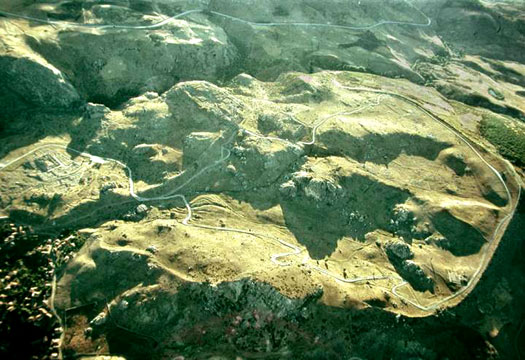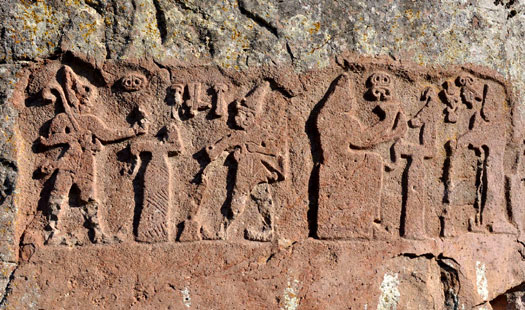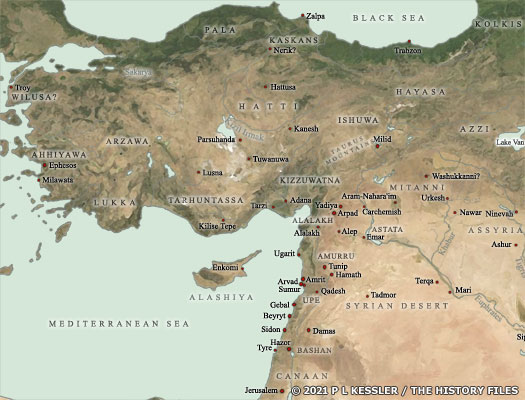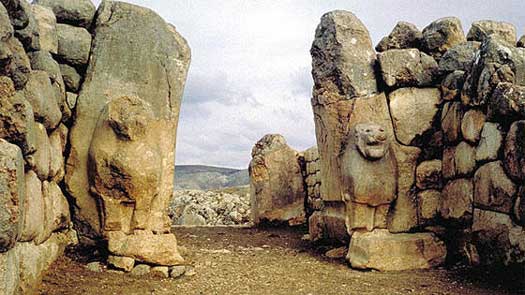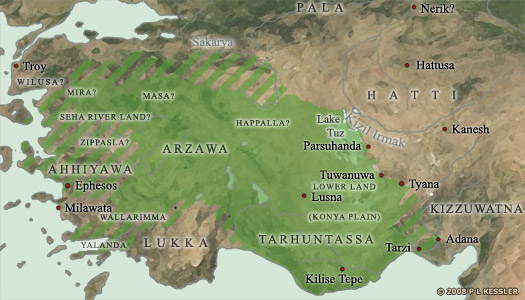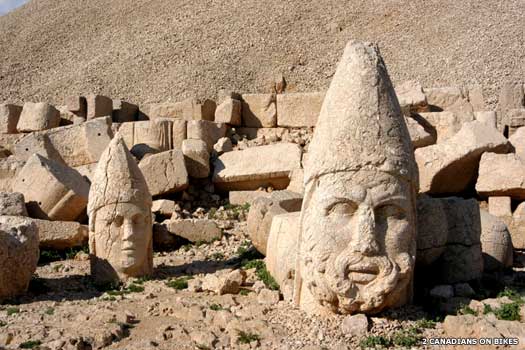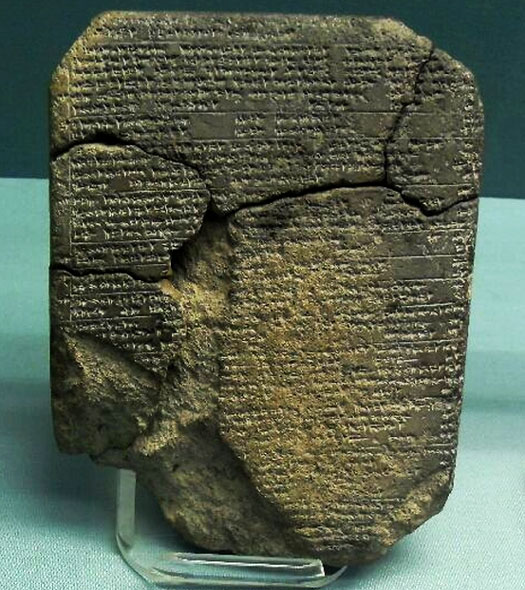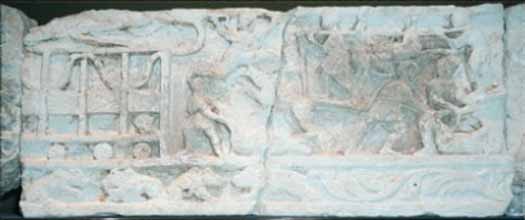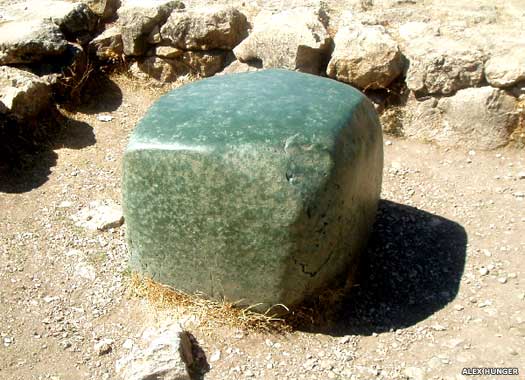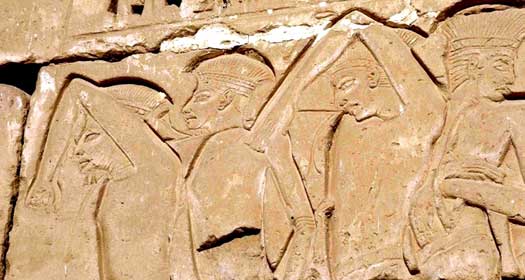
| HITTITES / HATTI (KHETA) Hittites / Hatti (Kheta) (South Indo-Europeans) :
The Hittites were an Indo-European people who emerged into history circa 1800 BC, by which time they were in the process of conquering a new home for themselves. They had arrived in Anatolia as part of the South Indo-European group of at least three main divisions, which eventually emerged into history as the Palaic-speaking Pala, the Hittites, and the Luwians.
Their pre-Anatolian-speaking ancestors had divided from the main collective of Indo-Europeans by 3500 BC, and perhaps up to a millennium earlier. They most likely headed down through the Caucuses by following one of the coastal routes, either along the eastern coast of the Black Sea or the western coast of the Caspian Sea. From there, following what may have been a period of cultural gestation in the southern Caucuses region, the Hittite group is presumed to have headed due west towards central Anatolia and the small city states of the Hatti. Once there they began fighting the Hatti people for dominance, revealing a level of militancy and possibly superior fighting numbers which made conquest preferable to subservience.
The Hittites must be clearly distinguished from the indigenous Hatti, the non-Indo-European people who already inhabited the region and who were probably direct descendants of the early farmer cultures in the region. They were conquered by the Hittites, who to all intents replaced them in their homeland, taking on their civilisation, gods, way of life, and elements of their language too (see feature link, right, for an examination of the origins of the Hittites). That process was not instantaneous though. Early Hittite kings bear what seem to be indigenous Anatolian names, hinting at a level of integration or temporary reverse dominance.
The early Hittites initially referred to themselves as Neshites (or Nessites, and their language as nešili), after the city of Kanesh which they conquered in the early eighteenth century BC. They were referred to as Hatti by their neighbours throughout their existence as a nation, and their state as 'The Land of the City of Hattusa', but this was largely down to their neighbours not being willing to distinguish between the indigenous Hatti and their conquerors. Egypt knew their land as Kheta (seemingly the same name but with a heavier accent). The Hittites are also mentioned in the King James Bible, translating their name as 'Children of Heth', the son of Canaan. Equating the historical Hittites or the later neo-Hittite states with the Old Testament's Hittites is still a matter of contention, even though the use of the Biblical name to refer to the historical Hittites is now commonplace.
(Information by Peter Kessler, with additional information by Edward Dawson, from The Horse The Wheel and Language: How Bronze Age Riders from the Eurasian Steppes Shaped the Modern World, David W Anthony, from Warfare in the Ancient Near East to 1600 BC: Holy Warriors at the Dawn of History, William J Hamblin (Routledge, 2006), from Hittite Diplomatic Texts, Gary Beckman (Second Ed, Scholars Press, Atlanta, 1999), from The Kingdom of the Hittites, Trevor Bryce (1998), from The Hittites, O R Gurney (1991), from The Hittites, J G Macqueen (1996), from Hittite Prayers, Itamar Singer (Scholars Press, Atlanta, 2002), and from External Links: Indo-European Chronology - Countries and Peoples, and Indo-European Etymological Dictionary, J Pokorny, and A Brief History of Hattusha/Bogazköy (from Archive.today), and Proclamation of Anittas (Hittite Online, Linguistics Research Center, University of Texas at Austin), and Anatolian Conference abstracts, Emory University, and Linguistics Research Center (University of Texas at Austin), and The historical geography of north-central Anatolia in the Hittite period: texts and archaeology in concert, Roger Matthews & Claudia Glatz (Anatolian Studies Vol 59, 2009, pp 51-72, available via JSTOR), and The great king Zuzu of Alahzina ,the Goddess Allani and the Stormgods of Kussara and Alala?, Joost Basweiler (available via Academia.edu).)
c.2300 BC :
Some time after this point, Luwian-speakers settle in Anatolia, just to the south of the (probably indigenous) Hatti. The Luwians are Indo-Europeans of the South Indo-European group - generally agreed to have been the first to migrate out of the original Indo-European homeland to the north of the Black Sea and Caspian Sea. The route they have taken in their migration is open to interpretation (and guesswork!), but a route through the Caucuses seems most likely, followed by a more easterly route around the eastern shores of the Caspian Sea. The Luwians form two major regional states, Arzawa and Kizzuwatna.
This map attempts to illustrate in basic terms the separate paths taken by the Luwians, Hittites, and Pala during their westwards migration and their progress from proto-Anatolians to kingdom-builders Around the same time, 'barbarians from the north' are causing problems in cities within Syria, likely to be Luwians testing their defences (see feature link for more on early Syria). The Hittites, however, make no such appearance in written records for a further five hundred years or so.
During this time they most likely remain in whatever grazing lands their cattle occupy to the south of the Caucus Mountains. Why they remain behind for so long when the Luwians have found a new home is unknown. Why they begin to move around the end of the nineteenth century BC so that they arrive in central Anatolia shortly after the beginning of the eighteenth century BC is equally unknown. Population increase and the need for fresh grazing land may be the best reasons. Or perhaps they are Luwians themselves, changed by association with the Hatti.
early 18th cent BC :
Pithana / Pitkhana / Bithana : Tribal leader. Became king of Hatti Kussara and then Kanesh.
Pithana, the earliest-documented Hittite ruler, and his son rule their newly conquered domain in Anatolia from the unlocated city of Kussara. Pithana later conquers the Hatti city of Kanesh, centre of the Assyrian trading colonies in Anatolia, perhaps moving his capital there (and probably ending Assyrian trading there too).
Neither Pithana nor Anitta bear Indo-European names, suggesting a degree of intermingling between the Indo-European Hittites and their immediate native Anatolian neighbours at some point in the last few centuries. Have the Hittites been integrating themselves into eastern Hatti territory over the course of several generations, only now to make a grab for power? Pithana is the first of what is sometimes referred to in modern texts as the 'Kussaran clan', the rulers of Kussara down to Tudhaliya I.
mid-18th cent BC
Anitta / Anittas : Son. King of Kussara & Kanesh.
At the very start of his reign Anitta defeats Piyusti, king of Hatti. A second battle at the city of Salampa sees Piyusti defeated again. He retreats and fortifies his capital at Hattousha (Hattusa), but Anitta storms and conquers it after famine has weakened the defenders. Anitta also attacks the city of Zalpa, recapturing the Kaneshan god and ending the threat from the north.
Next, Anitta turns his attention southwards and defeats the city of Salatiwara in two campaigns (which lies on a road connecting the kingdoms of Wahsusana and Purushanda). In the final stage of his campaigns, Anitta marches against the important city of Purushanda and the king surrenders without offering battle.
The city of Hattusa seen from the southern fortifications, with the ruins of the huge temple of the storm god in the centre
With these victories he brings the entire valley of the River Kizil
Irmak up to its mouth on the Black Sea under Hittite control. In
composing a text celebrating the victory - the 'Proclamation of
Anitta' (CTH 1) - Anitta creates the first Hittite inscriptions
and the earliest-known Indo-European writings. Anitta's kingdom
at Kussara collapses soon after his death, but his descendants remain
based there for another century.
Peruwa : Son. At Kussara? May never have become king.
Zuzzu / Zuzu : Last ruler at Kanesh. 'Great King'.
Kanesh is destroyed around this time by a king of Salatiwara, perhaps at the end of Zuzzu's reign as 'great king' of Kanesh. Zuzzu's name, like those of his ancestors, Pithana and Anitta, is not Indo-European. It seems to be an indigenous Anatolian name instead, showing either that the Hittites have been following non-Hittite leaders or that early Hittite and Hattian society has become integrated. Later Hittite names, though, are largely Indo-European.
This point represents the definitive end of the Assyrian trading colonies, with trade routes thoroughly disrupted by the recent chaos. Kanesh fades completely as the Hittites withdraw to Kussara, building a new state which becomes far more powerful during the 'Old Empire' period.
Old
Hittite Empire :
Following their initial defeat of the Hatti, and a century of obscurity as they settled into their new role as masters of eastern Anatolia, the Hittites bounced back to quickly centralise power and create a state of their own. They were culturally influenced by the Hurrians on their south-eastern border during this period, with several rulers bearing Hurrian names and Hurrian Vedic gods being worshipped (for instance at Yazilikaya). As in Egypt, their king was both the supreme judge and high priest. They also borrowed a large number of Hattic words into their language, especially references to the trappings of power, such as throne, lord, king, queen, palace, priest, heir-apparent, and many others. Both groups were of Indo-European descent, but from groups that had been divided from one another for over two thousand years, leaving plenty of time for separate lines of development and new ideas to be adopted.
In the second half of the seventeenth century BC, Hattusili I founded a new capital at Hattousha (Hattusa - modern Boğazkale in Turkey), which would remain the centre of the empire until its fall. While the Hittites destroyed the Amorite Old Babylonian empire, they also absorbed much of Mesopotamian culture, and were later responsible for disseminating it throughout the eastern Mediterranean. Although originally speakers of proto-Anatolian and its daughter language, Hittite, their later language must have been as greatly enriched and altered by their experiences as modern English has been by its own experiences with Danes, French Normans, Indian empire, and American settlements.
Three different dating theories are available for the New Hittites. The one used here matches most closely with the 'middle list', the others adding ten or twenty years onto these dates or taking roughly twenty years away from them. One or two gaps here are plugged from other sources. The uncertainties surrounding Hittite dating are still very great, so no one list can be said to be definitive. Despite their establishment of one of the great late second millennium BC empires, the surviving written record for the Hittites could do with a great deal of expansion.
All names can also be spelled to end with an 's' which would usually be pronounced with an 'sh' sound. Following the collapse of the earlier Hittite kingdom of Kussara, little is known about them until Hattusili I created the Old Hittite empire.
(Information by Peter Kessler, with additional information from The Horse The Wheel and Language: How Bronze Age Riders from the Eurasian Steppes Shaped the Modern World, David W Anthony, from Warfare in the Ancient Near East to 1600 BC: Holy Warriors at the Dawn of History, William J Hamblin (Routledge, 2006), from Hittite Diplomatic Texts, Gary Beckman (Second Ed, Scholars Press, Atlanta, 1999), from The Kingdom of the Hittites, Trevor Bryce (1998), from The Hittites, O R Gurney (1991), from The Hittites, J G Macqueen (1996), from Hittite Prayers, Itamar Singer (Scholars Press, Atlanta, 2002), and from External Links: A Brief History of Hattusha/Boğazköy (Archive.today), and Who were the Kaška?, Itamar Singer (The Argonautica and World Culture II, Phasis: Greek and Roman Studies, Vol 10 (II), Rismag Gordeziani (Editor-in-chief, Tbilisi, 2007, available as a PDF - click or tap on link to download or access it).)
c.1740 - 1710 BC :
Tudhaliya I? : King of Kussara, capital of the early Hittite state.
While not very powerful at this stage, the Hittites appear to make a tentative step towards expansion by establishing a colony at Yadiya, not too far to the south of Kanesh, in the northernmost reaches of Syria. This may be their very first outward expansion in this direction, and the colony is maintained by them until the final fall of the Hittites.
This was the situation in Anatolia which was inherited by the Hittites as they formed their early empire in the eighteenth century BC c.1710 - 1680 BC :
Pusarruma? : Son. King of Kussara.
c.1680 - 1650 BC :
Labarna I : King of Kussara. First confirmed Hittite king.
c.1670? BC :
The city state of Zalpa, resurgent after the Hittite victory under Anitta, is finally defeated by Labarna I. It is soon after this, during the reigns of Labarna (whether I or II is unclear) and Hattusili, that the Kaskans appear in the historical record - but only in thirteenth century Hittite records which recount events that may have been stretched backwards in time further than should be the case. These records can be attributed to Muwatalli II, stating that 'Labarna and Hattušili did not let them over the River Kumešmaha'. It is more likely that the Kaskans do not appear until the middle of the 1500s BC. Labarna II? : Reign uncertain. He may have renamed himself Hattusili.
c.1650 - 1620 BC :
Hattusili I : Nephew/adopted son of Labarna, but which is uncertain. Under Hattusili, heir to the throne of Kassura, the Hittites rapidly defeat their competitors in central Anatolia, probably inflicting a final defeat on the Hatti (notably at Purushanda), and establishing a new capital at Hattusa (a theory is that Labarna II takes the name Hattusili in recognition of the victory, meaning 'one from Hattusa'). Then they invade Arzawa in western Anatolia, and march across the Euphrates to destroy cities in Ishuwa.
This is followed up by the attack and destruction of several vassals of the Syrian state of Yamkhad over a span of several years, extending their own domains south into Syria. A Hittite viceroy is placed in control of the Syrian state of Carchemish, while in Amurru a local king is allowed to govern as a vassal. Ebla is also destroyed, either by Hattusili or his son. Later claims are made that ties of friendship with Wilusa date from this period, while apparent early dominance over Kizzuwatna may also date from this period.
The Hittite 'Old City' (which was probably based on the original construction of the preceding Hatti city) comprised an area of almost one square kilometre, being protected by a massive fortification wall, while on the high ridge of Büyükkale was the residence of the 'Great King', with the later extended city lying on the slope below, to the north-west, and reaching towards the valley below c.1620 - 1590 BC :
Mursili I : Grandson/adopted son. Murdered.
c.1595 BC :
Taking advantage of the increasing decline of Babylon, Mursili takes his army down the Euphrates and sacks the city. On the way he ransacks and destroys the city of Alep in Syria, and passes through Terqa. When he returns home he is murdered by his brother-in-law who seizes the throne.
c.1590 - 1560 BC :
Hantili I : Assassin and brother-in-law of Mursili I. Murdered.
c.1560 BC :
Having seized the throne through murder, Hantili reigns for around thirty years. Hittite power may have been damaged by this act though, or is in decline despite it. Thirteenth century Hittite records which can be attributed to Muwatalli II show that the state loses territory in the north to the Kaskans: 'The town of Tiliura was empty from the days of Hantili [presumed to be Hantili I] and my father Muršili [II] resettled it. And from there they [the Kaskans] began to commit hostilities and Hantili built an outpost against them... The [important religious] city of Nerik... was in ruins from the days of Hantili', ruined by the Kaskans.
Hantili's efforts against the Kaskans may not be successful as he is murdered towards the end of his long reign. Various parties then contest the throne and this internal instability prevents the Hittites from gaining any benefit from their conquests in Syria and Mesopotamia. The Hittite state does not re-emerge as a major power until the fourteenth century BC.
Puda-Hepa, Hattusili III's queen (on the right), proved highly influential in bringing Kizzuwatnan culture into the Hittite court in the thirteenth century BC - only for everything the two of them held dear to be swept away within two generations of their reign c.1560 - 1550 BC :
Zidanta I : Son-in-law of Hantili.
c.1550 - 1530 BC :
Ammuna : Son of Hantili. Lost Kizzuwatna to a revolt?
c.1530 - 1525 BC :
Huzziya I : Son?
Telipinu : Son of Zidanta I? Or brother-in-law of Ammuna.
Telipinu concludes a treaty with his south-eastern neighbour, the state of Kizzuwatna. The king's daughter is Harapšeki, who at some point is married to Alluwamna, the first Hittite ruler of the 'Middle Kingdom' period. However, the pair are banished to Malitashkur, so it is entirely possible that Alluwamna does not immediately succeed his father-in-law
Tahurwaili : First cousin. Reign uncertain. Some place him after Hantili II.
c.1525 - 1500 BC :
Tahurwaili agrees a parity treaty with Eheya of Kizzuwatna but the event cannot be dated with any precision. Whilst Tahurwaili may be a usurper around the time of Telipinu - or even a regent of some kind, although the treaty does seem to specify him being the Hittite ruler rather than holding power for someone else - some scholars place him later, between Alluwamna and Hantili II of the 'Middle Empire' period. Placing him this late does seem less realistic though.
Middle
Hittite Empire :
Once they had conquered and settled central Anatolia, and following a short spell of obscurity, the Hittites had quickly centralised their power in the form of their 'Old Empire'. A new capital had been formed at Hattousha (Hattusa, former city of the Hatti and now known as Boğazkale in Turkey), which would remain the centre of the empire until its fall. They had also been culturally influenced by the Hurrians on their eastern border during this period, with several rulers bearing Hurrian names and Hurrian Vedic gods being worshipped (for instance at Yazilikaya).
However, problems set in when Hantili I seized the throne through murder around 1590 BC. Hittite power may have been damaged by this act, or was in decline despite it. Thirteenth century Hittite records which can be attributed to Muwatalli II show that the state lost territory in the north to the ever-problematic Kaskans: 'The town of Tiliura was empty from the days of Hantili [presumed to be Hantili I] and my father Muršili [II] resettled it. And from there they [the Kaskans] began to commit hostilities and Hantili built an outpost against them... The [important religious] city of Nerik... was in ruins from the days of Hantili', ruined by the Kaskans. Hantili's efforts against the Kaskans may not have been successful as he was murdered towards the end of his long reign. Various parties then contested the throne and this internal instability prevented the Hittites from gaining any benefit from their conquests in Syria and Mesopotamia. The Hittite state did not re-emerge as a major power until the fourteenth century BC. Instead it was restrained by the successful Hurrian empire of Mitanni, unable to gain direct access to Syria. Relations were initially good with the neighbouring kingdom of Kizzuwatna on its south-eastern border but, at some point after about 1470 BC, the Kizzuwatnans were conquered by Mitanni, and the Hittites were even more cut off and unable to respond, prevented from expanding to the east or south (it should be noted that the Hittites were never entirely able to expand to the west, instead maintaining or encouraging client or allied kingdoms there such as Arzawa or Troy). While at this low point, Hittite record-keeping for this period was very sparse.
Three different dating theories are available for the Middle Hittites. The one used here matches most closely with the 'middle list', the others adding ten or twenty years onto these dates or taking twenty years away from them. One or two gaps here are plugged from other sources. The uncertainties surrounding Hittite dating are still very great, so no one list can be said to be definitive. Despite their establishment of one of the great late second millennium BC empires, the surviving written record for the Hittites could do with a great deal of expansion.
(Information by Peter Kessler, with additional information from The Arzawa Letters in Recent Perspective, J David Hawkins (British Museum Studies in Ancient Egypt and Sudan 14 (73-83, 2009)), from Ancient Israel and Its Neighbours: Interaction and Counteraction. Collected Essays Vol 1, Nadav Na'aman, from The Cambridge Ancient History, edited by I E S Edwards, from Hittite Diplomatic Texts, Gary Beckman (Second Ed, Scholars Press, Atlanta, 1999), from The Kingdom of the Hittites, Trevor Bryce (1998), from The Hittites, O R Gurney (1991), from Annals of Mursili (Years 1 to 8), Ian Russell Lowell, from The Hittites, J G Macqueen (1996), from Hittite Prayers, Itamar Singer (Scholars Press, Atlanta, 2002), and from External Links: A Brief History of Hattusha/Boğazköy (Archive.today), and Anatolian Conference abstracts (Emory University).)
c.1500 - 1490 BC :
Alluwamna : Son-in-law of Telipinu of the 'Old Empire'.
c.1500 BC
While the dates for Alluwamna may be hard to pin down with any precision, the case is the same for the name of his predecessor. It may be the uncertain Tahurwaili, but is more probably Telipinu who is attested in a treaty that had been signed with Kizzuwatna, although a period of exile for Alluwamna provides for some level of doubt. His wife is Harapšeki, the first-rank daughter of Telipinu, which at least ensures that the two rulers should be relatively close together on any list of kings.
Puda-Hepa, Hattusili III's queen (on the right), proved highly influential in bringing Kizzuwatnan culture into the Hittite court in the thirteenth century BC - only for everything the two of them held dear to be swept away within two generations of their reign During Alluwamna's reign, around 1490 BC, he renews a peace treaty with Paddatišu of Kizzuwatna in the aforementioned treaty, only a few years before that kingdom is conquered by the increasingly powerful Mitanni state.
c.1490 - 1480 BC :
Hantili II : Son. Fought Tahurwaili?
c.1490 BC
Hantili renews the treaty of friendship with his south-eastern neighbour, Kizzuwatna, and its king, Paddatišu. However, Hantili is not specifically named in the treaty, so it could be his father who concludes it. Then there is the interloper Tahurwaili who is mentioned at the end of the 'Old Empire' period. Some scholars place him between Alluwamna and Hantili (or even after Hantili), suggesting a brief usurpation of the throne. Placing him this late does seem less realistic though.
c.1480 - 1470 BC :
Zidanta II : Nephew?
c.1480 - 1475 BC
Although relations with Kizzuwatna are initially rocky, with both kingdoms grabbing territory from each other, Zidanta eventually agrees a new parity treaty with King Pilliya (II). It is the last such treaty to be agreed between the two states.
c.1470 - 1460 BC :
Huzziya II : Relationship uncertain. Killed by Muwatalli.
c.1470 BC
Subject to frequent raids from Alakhtum, the faction-torn Hittites are unable to respond. Huzziya is murdered by Muwatalli, his own 'Chief of the Royal Bodyguard', perhaps the first break with the ancient royal bloodline. Around the same time, neighbouring Kizzuwatna is conquered by Mitanni. With Ishuwa also independent of Hittite control (and now a vassal of Mitanni), the Hittites are contained in central Anatolia except for the south-eastern Taurus passes into Syria.
c.1460 - 1450 BC :
Muwatalli I : Reign uncertain. Most lists place Tudhaliya at 1460 BC.
c.1450 BC
In what is possibly far more brief a reign than is suspected here, Muwattalli, a former 'Chief of the Royal Bodyguard', is killed in a palace coup by Himuili, the 'Chief of the Palace Servants', and Kantuzili, the 'Overseer of the Gold Chariot Fighters'.
The Lion Gates of the Hittite capital were of a style popular throughout the ancient Near East, with an example being found in Mycenae and a later version existing in Jerusalem A succession struggle follows which is scarcely documented at all. Muwa, 'Chief of the Royal Bodyguard' and probably the brother of the dead king, flees to Mitanni and solicits their help. On the other side of the struggle, Kantuzzili joins forces with a man named Tudhaliya. The two factions meet in battle, and Tudhaliya and Kantuzzili emerge victorious. Of the conspirators, it is Tudhaliya who becomes the next great king of the Hittites, ushering in the 'New Empire' period.
New
Hittite Empire :
The previous century had been one of domination by the Hurrian empire of Mitanni. The Hittites in their 'Middle Empire' phase had been unable to expand east or south and were largely confined to local Anatolian political efforts. Now a resurgent Hittite empire began to change the balance of power, with the Assyrians further east doing the same. At the same time, non-Indo-European barbarians such as the Kaskans began to strengthen in northern Anatolia, and a region or state known as Ahhiyawa was first mentioned on the Anatolian coast of the Aegean.
Geographically, the borders of the reinvigorated Hittite empire shifted constantly. The capital city was in central Anatolia in the basin of the River Kizil Irmak, and military expansion efforts focussed mainly on the south in Syria. It is unclear precisely where the northern and western borders lay, but the Kaskans in the north were at times clients of the Hittites, although barely manageable ones. As the state's organisation was not by direct territorial control but by domination over vassals, the borders were determined by the level of control which could be exercised over those vassals. The southern region of Tarhuntassa in particular began to exercise more independence as central power declined towards the end of the empire, and on the south-western Mediterranean shore, the Lukka were never entirely tamed.
Three different dating theories are available for the New Hittites. The one used here matches most closely with the 'middle list', the others adding ten or twenty years onto these dates or taking twenty years away from them. One or two gaps here are plugged from other sources. The uncertainties surrounding Hittite dating are still very great, so no one list can be said to be definitive. Despite their establishment of one of the great late second millennium BC empires, the surviving written record for the Hittites could do with a great deal of expansion.
(Information by Peter Kessler, with additional information from The Arzawa Letters in Recent Perspective, J David Hawkins (British Museum Studies in Ancient Egypt and Sudan 14 (73-83, 2009)), from Ancient Israel and Its Neighbours: Interaction and Counteraction. Collected Essays Vol 1, Nadav Na'aman, from The Cambridge Ancient History, edited by I E S Edwards, from Hittite Diplomatic Texts, Gary Beckman (Second Ed, Scholars Press, Atlanta, 1999), from The Kingdom of the Hittites, Trevor Bryce (1998), from The Hittites, O R Gurney (1991), from Annals of Mursili (Years 1 to 8), Ian Russell Lowell, from The Hittites, J G Macqueen (1996), from Hittite Prayers, Itamar Singer (Scholars Press, Atlanta, 2002), and from External Links: A Brief History of Hattusha/Boğazköy (Archive.today), and Anatolian Conference abstracts, Emory University.)
c.1450 - 1420 BC :
Tudhaliya II (I) : Son of Huzziya II? Shown as Tudhaliya I in some lists.
fl 1430s BC :
Mattiwaza / Madduwattas : King of Alashiya. Hittite-backed contestant for Arzawa.
c.1430 BC :
Tudhaliya begins a restoration of Hittite power, conducting his third campaign against the Kaskans in the north. Arzawa concludes a treaty with Tudhaliya, but when Ahhiyawa conquers Madduwattas' kingdom of Alashiya, Tudhaliya installs the latter in the mountain country of Zippasla and supports his attempts to capture the Arzawan throne. This installation would seem to be more of a re-installation, as Madduwattas has already fought several battles against the Arzawan king.
The state of Arzawa existed from at least 1650 BC. By around 1450 BC it controlled the solid green section of the map, which included the state of Tarhuntassa, but probably not the 'Lower Land' The eastern land of Ishuwa is defeated by the Hittite king, and then sides with Mitanni. Tudhaliya is unable to capture Ishuwa, revealing the limits of Hittite power in this period, so instead he successfully attacks Kizzuwatna, a Mitanni possession. However, he does order Madduwattas to put down a revolt in Happalla. Madduwattas does so, but then forces Happalla to switch its loyalty to him. Then he bullies Pitassa into his kingdom, which brings Arzawa's borders even closer to the Hittite heartland.
c.1420 - 1400 BC :
Arnuwanda I : Son-in-law.
c.1400 BC :
Kizzuwatna falls to the Hittites when Arnuwanda's army overruns it. On the western border, Arnuwanda continues the support of Madduwattas, aiding him in eventually winning the throne of Arzawa. Madduwattas then expands his state right up to the Hittite borders. Arnuwanda is distracted by serious problems that he has with the Kaskans, with many northern territories falling into their hands, including the cult centre of Nerik.
c.1400 - 1380 BC :
Tudhaliya III (II) : Son. Not in all lists and his rule is uncertain.
c.1392 BC :
The Hittites wrest domination of the Assyrians from Mitanni, possibly annexing their territory to Kizzuwatna. The change is to the benefit of the Assyrians as they are able to end a period of vassal kings and gain more freedom under their new overlords.
c.1400 - 1380 BC :
Hattusili II : Precise position in the list is uncertain.
c.1380 - 1370 BC :
Tudhaliya IV (III) : Son of Tudhaliya III. Weakened by illness and dethroned.
c.1375 BC :
The Kaskans suffer the loss of their grain to locusts so, in search of food, they join up with the eastern states of Hayasa-Azzi and Ishuwa, plus the Lukka and other Hittite enemies. The devastation to the grain crops may also have been suffered by others, making it not only easy to get them all to unite but highly necessary, and the Hittites may be taken by surprise by the sheer forcefulness of the attack. Recent Hittite resurgence suffers a knock when their fort of Masat is burned down, but then the capital, Hattusa, is itself attacked and burned (although the event is shrouded in mystery). Possibly the secondary capital at Sapinuwa is also attacked and burned.
Representative of some of the terrain in Hayasa-Azzi is Mount Nemrut, north of Lake Van, which in the first century BC became a tomb sanctuary for the kings of Commagene The Kaskans make Nenassa their frontier, while Hayasa-Azzi seizes the Hittite city of Samuha. Despite being an able and active ruler before illness keeps him off the battlefield, events are clearly against Tudhaliya. The Hittite state loses its international standing, and also loses most of its possessions both near and far, to the extent that the Egyptians wonder if the state has fallen entirely. However, while this disaster personally weakens the position of the Hittite king, it seemingly does little to set back the Hittites themselves.
c.1370 - 1336 BC :
Suppiluliuma I : Took the throne in coup. Son of Tudhaliya III. Died of plague. Upon seizing the throne, Suppiluliuma pushes back an invasion by the Kaskan barbarians and invades Hayasa-Azzi. Then he inflicts a shock defeat on the Hurrian empire of Mitanni (working with his son, Piyashshili), initiating that powerful state's decline and effectively creating the Hittite 'New Empire'. Piyashshili is given the territory of Ashtata to rule from Carchemish. However, Suppiluliuma is not entirely successful at first in pushing back Arzawa, which is very powerful at this stage.
During his reign, the Hittites also solidify their control over the south and east of Anatolia (including in Tarhuntassa and Ishuwa), play politics in Arzawa, gain Mitanni territory in northern Syria, and suppress a rebellion in Kizzuwatna. The city state of Alalakh is drawn directly under Hittite rule, removing the local rulers, while Amurru, Emar, Qadesh (scene of the great thirteenth century BC chariot battle against Egypt), and Ugarit become vassals, Carchemish and Alep are ruled by sons of Suppiluliuma, and Hittite control extends as far south as Damas, while Wilusa remains an ally.
c.1339 BC :
The Syrian Mitanni territory falls completely under Hittite overlordship, to all intents and proposes ending Hurrian culture. At the same time the Assyrians regain their independence. The subject state of Amurru switches allegiance to the Hittites.
c.1336 - 1333 BC :
Arnuwanda II : Son of Suppiluliuma. Incapacitated by plague.
c.1333 - 1308 BC :
Mursili II : Brother. May initially have shared power with Arnuwanda.
c.1326 - 1321 BC :
Devoting attention to the areas of Anatolia which had been ignored by his father, Mursili defeats Arzawa around 1325 BC, with the result that it disappears as a cohesive state (this event has also been dated to around 1306-1305 BC). The Hittites with their greatly expanded Anatolian territory now border Ahhiyawa in the west. Mursili also attacks the Kaskans to the north, but in the seventh year of his reign, Hayasa-Azzi raids the land of Dankuwa on the Hittite border, capturing the area's population and beginning four years of warfare. The Hittite general, Nuwanza (Nuvanza), resoundingly defeats them in the Upper Land before a campaign finally subdues the Hayasians.
The treaty agreed between Mursili II and Talmi-sharruma of Aleppo to regulate future relations between the two states - most of the document survived three millennia of abandonment before being rediscovered by archaeologists c.1308 - 1282 BC :
Muwatalli II : Son of Mursili II.
c.1300 BC :
The now-independent Assyrians begin to take control of Mitanni, while Muwatalli moves his capital to the previously obscure city of Tarhuntassa in southern Anatolia (possibly due to the Kaskan sacking of Hattusa). He leaves his brother, the future Hattusili III in charge of the northern areas, from where he re-conquers Hattusa and the long-ruined cult centre of Nerik, allowing the capital to be returned to the north. Muwatalli is also in contact with his ally, Alexandros of Wilusa, regarding the remaining Arzawan client states.
1286 BC :
The Battle of Kadesh/Qadesh (the earliest surviving report of a major engagement) sees the forces of Egypt, under Ramses II, and the Hittites together with their various allies, including troops from Arzawa and the Lukka, clash for control of former Mitanni Syria. The battle ends with no clear outcome although the Hittites come out on top, gaining uncontested control of Syria, and also raiding further south into Canaan. Kadesh is given over to the Hittite subject state of Ashtata. The victory, though, seems to spark the beginnings of a civil war in the Hittite nobility which lasts for about three generations.
c.1280 BC :
Muwatalli concludes a treaty with his ally, Alexandros/Aleksandu of Wilusa, regarding the remaining Arzawan client states. The Arzawan state of Masa (on the south-eastern border of Wilusa's territory) attacks Alexandros and is destroyed (again) by Muwatalli.
This Hittite tablet mentions the kingdom of Arzawa, although generally the Anatolia kingdom is little-known and barely mentioned in the historical record c.1282 - 1275 BC :
Mursili III (Urhi-Teshub) : Son by a concubine. Deposed by his uncle.
c.1282 - 1275 BC :
In the north Mursili's uncle, Hattusili, uses his powerbase to undermine Mursili, eventually deposing him, seemingly with the help of the deposed Benteshina of Amurru. This is unheard of, and it shatters the bond of trust between kings and nobility - the kingship is no longer sacred and untouchable. Mursili makes his powerbase in Arzawa, where he is supported by the populace. Hattusili makes Mursili's son, Karunta, 'king of Tarhuntassa' in the south, while officially exiling Mursili himself to an outlying part of the state.
c.1275 - 1250 BC :
Hattusili III : Brother of Muwatalli II. Hattusili's queen, Pudu-Hepa, formerly a priestess from Kizzuwatna, aids the integration of the Kizzuwatnan pantheon into the Hittite one, with the goddess Hebat becoming very important. To the west, Ahhiyawa first becomes a major regional power at this time, and the Hittite ally in Wilusa is overthrown.
1258 BC :
Egypt and the Hittites (under Hattusili) agree the earliest known peace treaty, allowing them to peacefully share Syria (including what is now Lebanon). The treaty remains in force for forty years. From Hattusili's point of view, the agreement may be important in legitimising his rule, as well as guaranteeing a level of security against the threat of Assyrian aggression, now that they have conquered much of eastern Mitanni.
The green cubic stone at Hattusa was probably a gift to the Hittite rulers of the city from the Egyptian pharaoh with whom they signed a peace treaty in 1258 BC c.1250 - 1241 BC :
Tudhaliya V (IV) : Son of Hattusili III. Deposed?
c.1241 - 1240 BC :
Karunta : Son of Muwatalli / cousin of Tudhaliya V. Only briefly great king?
Karuta, king of Tarhuntassa, may temporarily depose his cousin, as he appears as 'Great King' on seals found at Hattusa. Tudhaliya regains the throne, but Assyria attacks the state from the east, and vassals in the west and south-west of Anatolia rebel. Trouble in the regions adjoining the Aegean may be inspired by an elusive 'king of Ahhiyawa', situated between the coast and the former state of Arzawa. He is a major player, but hard to pinpoint in any detail, and Tudhaliya is unable to suppress him despite taking Milawata (classical Miletus).
c.1241 - 1220 BC :
Tudhaliya V (IV) : Restored? Confirmed Karunta's rule in Tarhuntassa.
c.1230 BC :
Amurru concludes a treaty with the Hittite king, preventing seaborne trade between Assyria and Ahhiyawa as the struggle between the two states for domination of western Anatolia heats up.
c.1220 - 1215 BC :
Arnuwanda III : Son of Tudhaliya V.
Suppiluliuma II : Brother. Fate unknown. Last Hittite king.
c.1215 - 1200 BC : Tarhuntassa attacks the Hittite state, but no further details are known. Suppiluliuma II is occupied with engaging Alashiya in sea battles as he attempts to invade the Cypriot kingdom.
c.1200 BC :
The international system has recently been creaking under the strain of increasing waves of peasants and the poor leaving the cities and abandoning crops. Around the end of this century the entire region is also hit by drought and the loss of surviving crops. Food supplies dwindle and the number of raids by habiru and other groups of peoples who have banded together greatly increases until, by about 1200 BC, this flood has turned into a tidal wave.
Attacks by the Sea Peoples gathered momentum during the last decade of the thirteenth century BC, quickly reaching a peak which lasted about forty years Already decaying from late in the thirteenth century BC, as Assyria has risen and instability has gripped the Mediterranean coast, the Hittite empire is now looted and destroyed by various surrounding peoples, including the Kaskans and the Sea Peoples (and perhaps even selectively by its own populace). Some important Hittite cities and states, such as Tarhuntassa and Ugarit, disappear - and Milawata (classical Miletus) is destroyed - but others, such as Carchemish, survive. Hittite elements, now homeless, appear to join the Sea Peoples in subsequent raids on Egypt.
Small Hittite (or 'neo-Hittite') states form out of some territories: in western Anatolia, Maeonia emerges as an independent kingdom; in the south-west, Lycia; in south-central and eastern Anatolia, Kummuhu, and Tabal; while north-east of Maeonia, an Indo-European people who are allied to the Kaskans form the kingdom of Phrygia; the Sea Peoples ravage eastern Anatolia and Syria (and some scholars associate them with Tabal). The Philistines, more displaced settlers, arrive on the coast of Canaan. Further neo-Hittite states continue to survive in northern Syria, and some are mentioned in the Old Testament. This is also the generally-accepted period in which the Israelites begin creating a kingdom.
Source :
https://www.historyfiles.co.uk/ |

